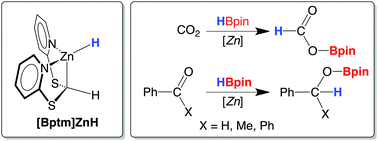Daniel G. Shlian, Erika Amemiya and Gerard Parkin
Chem. Commun., 2022,58, 4188-4191
DOI:
10.1039/D1CC06963B,
Communication
The reactions of bis(2-pyridylthio)methane with Me2Zn and Zn[N(SiMe3)2]2 afford [Bptm]ZnMe and [Bptm]ZnN(SiMe3)2, thereby providing access to a variety of other [Bptm]ZnX derivatives, including the zinc hydride complex [Bptm]ZnH, which serves as a catalyst for the reduction of CO2 and other carbonyl compounds via hydrosilylation and hydroboration.
